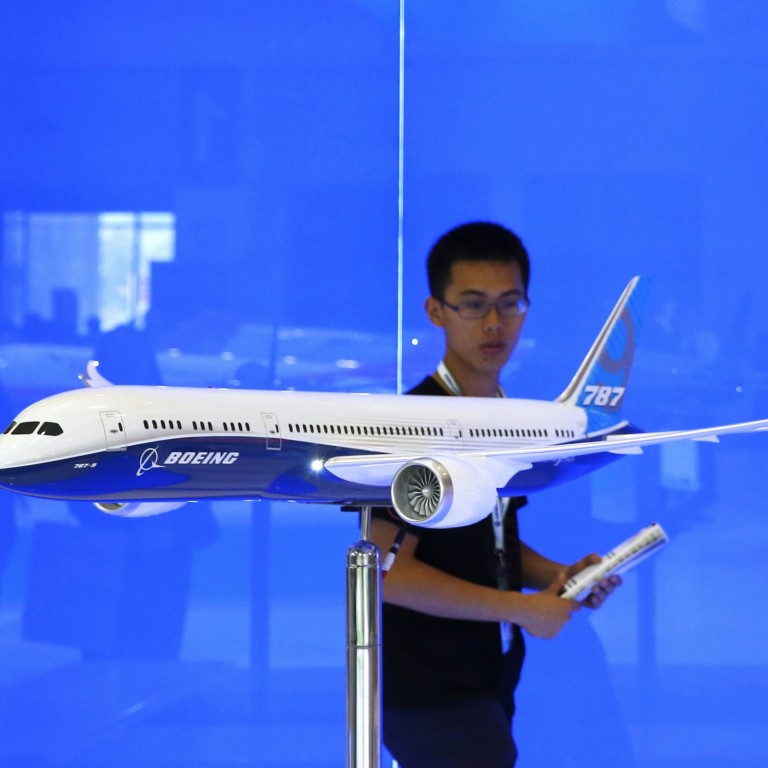
Ethiopian Airways flight came within 570 metres of Hong Kong hill authorities reveal, and say they are investigating four serious ‘loss of control’ incidents in city’s skies
- Ethiopian jet was carrying 235 people and passed perilously close to Tai Mo Shan on July 18
- Boeing 787s belonging to Etihad Airways and Virgin Atlantic also involved in other incidents between July and October last year
Air accident officials are investigating after an Ethiopian Airways flight carrying almost 250 people veered off course, lost altitude, and came within 570 metres of the highest peak in Hong Kong on its approach to the city’s international airport.
The incident on July 18 last year is one of four serious “loss of control” mishaps the Air Accident Investigation Authority (AAIA) revealed it was looking into. All involved Boeing 787s deviating from flight paths at similar locations above Hong Kong.
Aircraft belonging to Etihad Airways and Virgin Atlantic were also involved in similar incidents between July and October 2019.
In the first incident, the Ethiopian jet with 235 people on board was lining up to land using an instrument landing system (ILS), or localiser, which helps guide pilots, but deviated from its flight path.
According to an AAIA report, the aircraft kept diverging to about 1 nautical mile (1.85km) north from its flight path, and descended to a lower altitude of 3,700 ft, where the distance between it and “the height of 3,277 ft was 570 metres” – a description understood to be referring to the Tai Mo Shan area.
“Air Traffic Control (ATC) warned the pilots and instructed the aircraft to climb to 4,500 ft,” the report said.
All four incidents occurred at the “River” waypoint, which is a type of fixed aerial location to help aircraft navigate as they pass over Tai Mo Shan, Hong Kong’s highest peak.
None of the jets suffered any form of damage and each landed uneventfully.
Three of the most recent cases involving the Etihad and Virgin 787s were disclosed this week, after the AAIA published preliminary reports, setting out the facts of the incidents and appealing for interested parties – including airlines, aircraft manufacturers and aviation regulators from respective countries – to submit information.
Aviation authority orders probe into air traffic control system after glitch
Aircraft use the ILS mechanism because it offers precision guidance laterally and horizontally from a defined point. A professional pilot who flies in and out of Hong Kong International Airport regularly said deviation from the flying aid meant obstacle clearance was not guaranteed.
The report stated this occurred to the aircraft.
The source explained it was important for aircraft to be using the instrument since the alternative, relying on pilot vision, would mean navigating through clouds or haze during runway approach.
For example, Cathay Pacific pilots must be locked onto the mechanism at a certain distance or go around for a second landing bid.
An Etihad jet on September 7, was involved in the second incident carrying 179 people. It synced with the ILS at 15 nautical miles, and descended below the minimum altitude to about 4,300 ft. The plane re-established a connection with the localiser at 11 nautical miles from the runway. It subsequently landed.
In the first of two Virgin incidents, flight VS208 on September 29 carrying 249 people had connected with the ILS, but deviated to the right and subsequently below the minimum altitude in that area, prompting ATC to order a go-around. The aircraft landed safely after the second approach.
For flight VS208 on October 18 with 271 people on board, the aircraft was linked up with the ILS but “overshot” its parameters, heading “towards the rising terrain in the north”, according to the report.
The pilot responded by taking over manual control, and connected with the localiser 12 nautical miles from the runway before landing “uneventfully”.
Two Cathay Pacific captains lose eyesight during flights, sparking investigations
The AAIA said each investigation was anticipated to take 12 months.
An Etihad spokeswoman said: “We have received the report and are participating in the investigation. Safety is the highest priority of Etihad Airways.”
A Virgin Atlantic spokeswoman said: “The safety of our customers and crew is always our top priority and as per procedure, our pilots immediately reported the incidents and we are now working with the authorities on a full investigation.
“In addition, we carried out our own rigorous internal investigations in conjunction with Boeing.”
The Post has reached out to Ethiopian and Boeing for comment.


